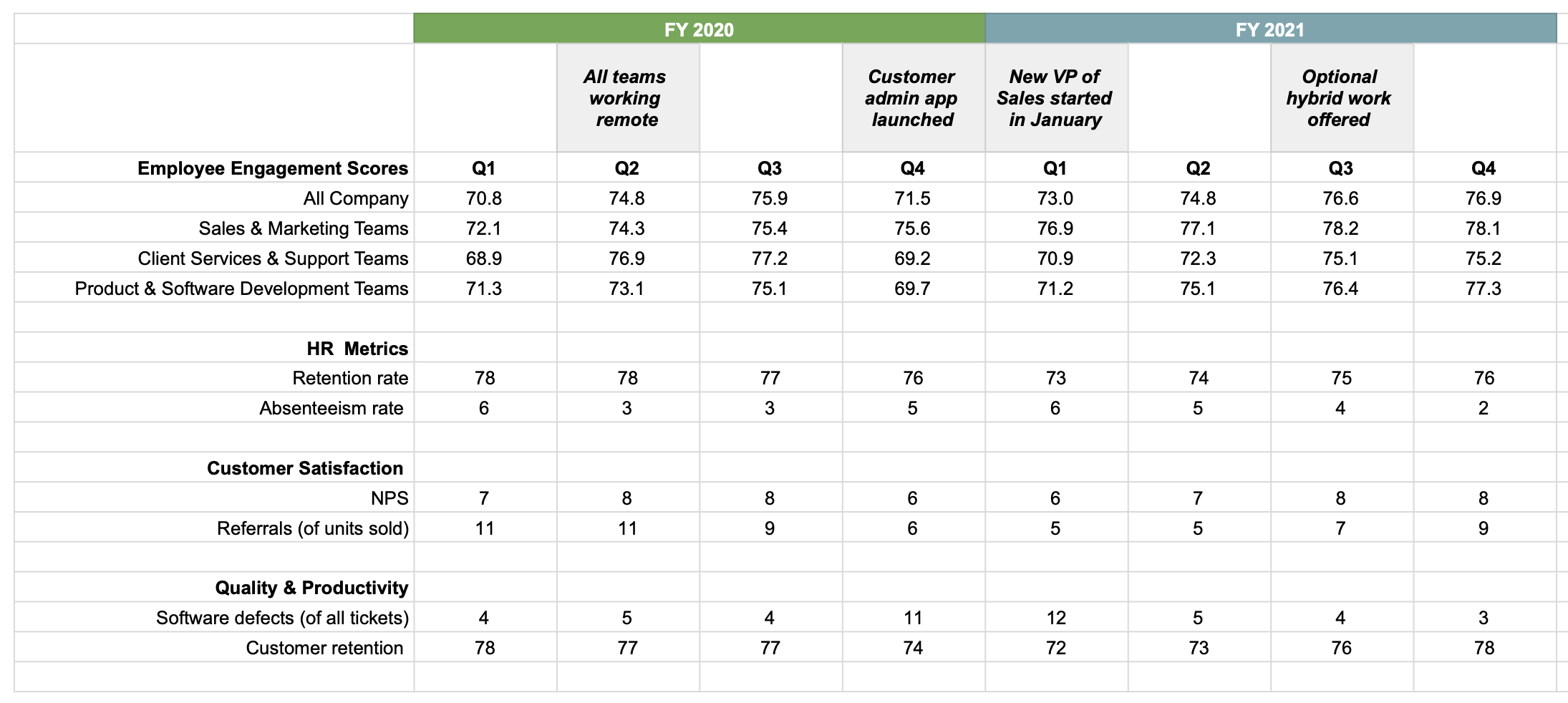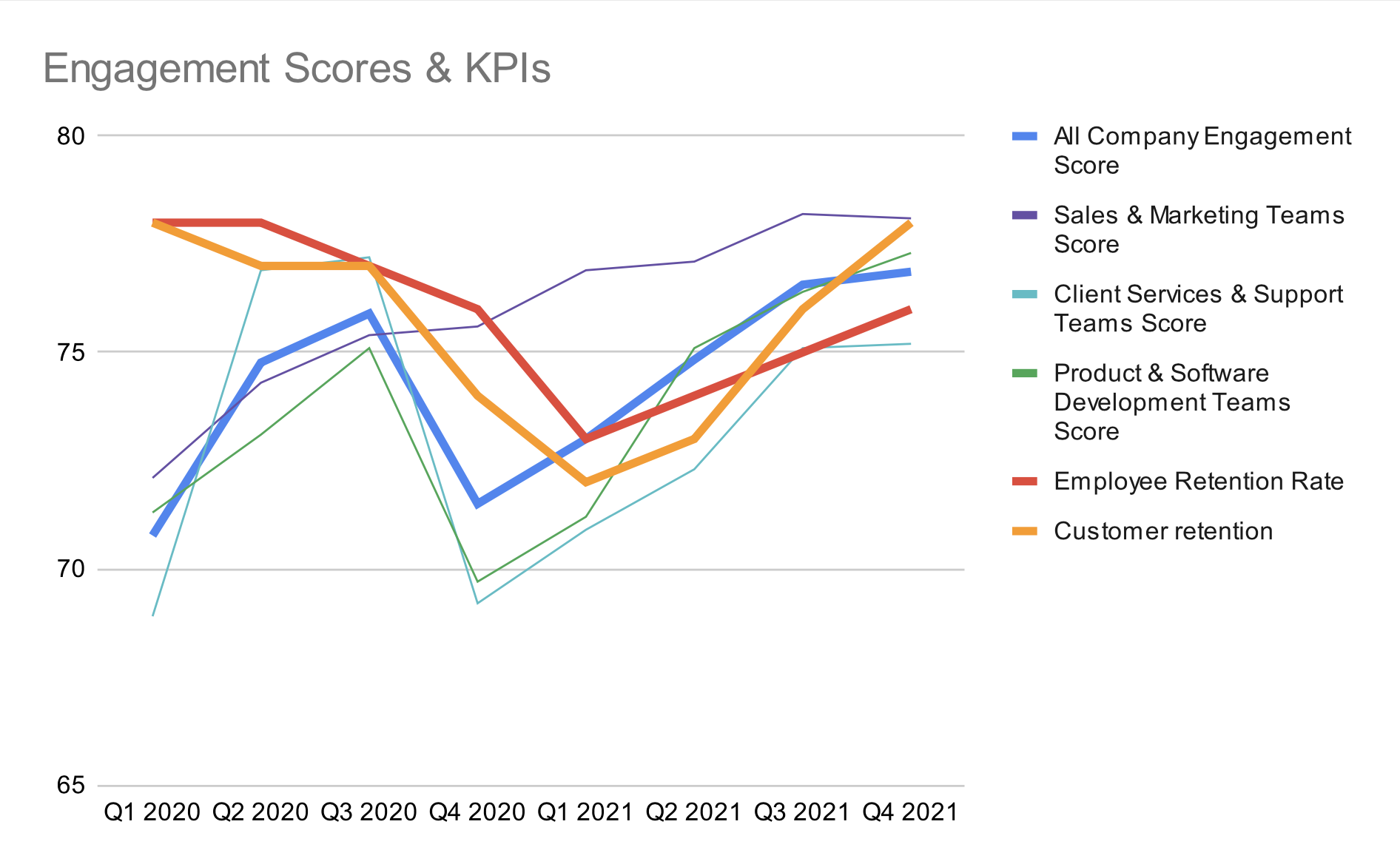The benefits of employee engagement are manifold: surveys, studies and papers galore agree that better morale, improved employee retention, increased productivity, more innovation and higher levels of employee satisfaction are some of the benefits of having an engaged team.
This sounds well and good, but understanding the business benefits your organisation has realised is crucial for fully understanding the ROI of our employee engagement programme.
However, there’s more to it than simply calculating the ROI of employee engagement. When you track various metrics over time, you start to see the relationships between the data – and employee engagement is no different.
Capturing this data consistently throughout the year (we recommend quarterly, to correspond with your engagement survey) has multiple advantages:
- You’ll be able to see correlations between your team’s level of engagement, and other important metrics, such as absenteeism and customer retention.
- You can quickly understand the impact of significant events, such as a new senior hire, a reorganisation, integrating teams after a merger or acquisition, or the gain or loss of a major client, on the engagement of your employees.
- Charting employee engagement and business outcomes creates powerful alignment amongst leaders, helping them keep people priorities in focus.
- Patterns may emerge that can be used for predictive models.
At the end of this article, we discuss how to construct a scorecard for your organisation. However, before we do that, we first need to identify metrics within the company that can be used to measure the ROI of employee engagement.
Track data that captures the impact of employee engagement
We’ve discussed the benefits of employee engagement and why it’s so important to the business in previous articles, so we’re not going to focus on those topics here. Instead, we’re going to concentrate on identifying the multitude of different KPIs and metrics that can vary with employee engagement.
HR metrics that can be impacted by employee engagement levels
Some of the most obvious and easiest to track metrics that are impacted by a company’s employee engagement levels are also some of its most important: particularly the employee turnover rate and the absenteeism rates. When those rates worsen, the negative impact on the business can be felt immediately.
- Employee turnover rate: The employee turnover rate is a simple calculation – it’s the number of employees who left the company during a specific period of time, divided by the average number of employees for the same period.
Employee turnover rate = (Number of employees who left the company) / (Average number of employees for that same period of time)
- Absenteeism: This one is a little trickier to measure, but also vitally important, as it captures the rate of unplanned absences that occurred over a period of time. Planned time off should not be included in this calculation. To correctly calculate your firm’s absenteeism rate, use this formula:
Absenteeism Rate = (Average Number of Employees X Unplanned Missed Workdays) / (Average # of Employees X Total Workdays)
- New hire retention rate: Whether or not a new hire receives satisfactory onboarding can have a remarkable effect on that person’s success and longevity with the company.
TIP: For this reason, we recommend segmenting your employees by hire date for your engagement surveys. Understanding the differences in engagement levels between your newest hires and more established employees can provide important insight leaders can use to improve culture and performance.
New Hire Retention Rate = (Number of New Hires) / (Number of New Hires who voluntarily left during the same time period)
How quality of work and employee engagement are related
It may not seem intuitive to measure software defects or the percentage of service calls that can be resolved in one call, but when you consider the elements of employee engagement, such as a clear understanding of one’s role and responsibilities, having the tools and training to do one’s job, and an environment in which employees have an authentic voice, the relationship between quality of work and employee engagement becomes clear.
Here are several different ways to measure the quality of work and its impact on employee engagement.
One important note: it’s important to identify dependencies between teams and the downstream effects one team can have on another. One example: poor software support documentation, which can have terrible consequences for the service team taking the calls. Bad documentation is squarely in the ‘tools and training to do one’s job’ category of engagement elements, and a support team struggling to help customers in this scenario could become disengaged very quickly.
- First-call resolutions. Average call resolutions – and the percentage of which are resolved in one call – can be incredibly revealing metrics, as they can pick up problems with the product, sales process or support plan. Most organisations track and benchmark the number of calls required to resolve a client service issue. How that number varies over time can be directly affected by how well employees are communicating, collaborating, and performing – in other words, how engaged they are.
- Adoption rate. The rate at which customers adopt a new feature or service can be a lagging indicator of work quality. When an organisation rolls out a feature or service that isn’t used, that investment generates little return, and profitability is diminished. Development teams that work off poor information, for example, or service teams lacking the knowledge to promote or support the feature, can see their engagement slide when something they worked on misses the mark. Savvy leaders know to investigate why adoption was low. For additional insight, they should look into the engagement data for the related teams.
- Software defects (calculated per release) or defective products. Charting average defects per release or production run creates motivation to manage that number downward, and at the same time, provides a simple way to assess how well the product development process is working. You may not immediately correlate employee engagement with better software development or production processes. However, great software is built on equally good collaboration, which is where team engagement can be crucial.
The same holds true for physical products. Whether we’re talking about incorrect pizza orders or auto parts that don’t work, defects are an indicator of issues within the process, communications or employee morale and engagement. Measuring the number of defects and tracking those numbers along with your engagement score can provide insights that can help you resolve issues that directly impact your customers.
Customer satisfaction & employee engagement
It doesn’t take much imagination to see how customer satisfaction and employee engagement are interrelated. However, the impact is greater than happy employees providing cheerful service. Engaging your employees can improve customer retention and to more referred business – both of which are profit drivers.
Your business is probably already quantifying customer satisfaction and loyalty. Common measures include:
- Customer loyalty or retention rates,
- Reviews scores,
- Referrals received,
- Testimonials requested/received.
Where things get really interesting is when you add employee engagement into the mix, and then observe how the measures fluctuate, and the degree to which they do so in line.
Employee involvement in internal initiatives
A less obvious beneficiary of a more highly-engaged employee team is the willingness with which people will embrace and participate in surveys, internal initiatives, committees, and programmes. Charting the participation in these types of activities is an indicator of their likelihood of success.
Two activities are worth watching, in particular: survey participation, and active users of the company intranet or collaboration tools. Often, as employee engagement rises, survey participation will increase, especially when people realise that leadership is taking action in response to employee feedback. A benefit of rising engagement is better collaboration. As your team’s engagement rises, you can expect to see an uptick in activity on the intranet or your collaboration tools. If adoption of these has been lagging, consider asking your more-engaged team for their feedback, and then involve them in improving the tools – this will also help increase utilsation (and with it, collaboration.)
Examples of metrics that measure employee involvement include:
- Survey participation rate.
- Active users of the company intranet or collaboration tools.
- Participation in company programmes, e.g.
- Volunteers for committees, initiatives, and ad-hoc projects,
- Employee-led initiatives, such as “lunch & learn” and mentoring programmes.
Create an at-a-glance scorecard combining key metrics across the business
Once you’ve established your performance measures, you can now create a scorecard marrying employee engagement data with selected indicators from across the business. Capturing this data consistently will allow leaders to readily see fluctuations in engagement and knock-on effects in other areas to quickly measure the ROI of employee engagement.

When you capture and assess this data consistently, your team will be able to make the connection between employee engagement and the business, creating a heightened awareness of the importance of the employee experience and the team’s morale. This can generate more buy-in for the engagement strategy, paving the way toward building a truly high performing team.

Put another way, employee engagement is a way to measure the health and effectiveness of an organisation’s most valuable asset – its people. As our founder, Stefan Wissenbach, noted in a recent article, employee engagement is a strategic imperative and belongs on the boardroom agenda. Understanding how engagement affects – and is affected by – other organisational metrics will help leaders measure the ROI of employee engagement and see it as a vital tool for ensuring success.



